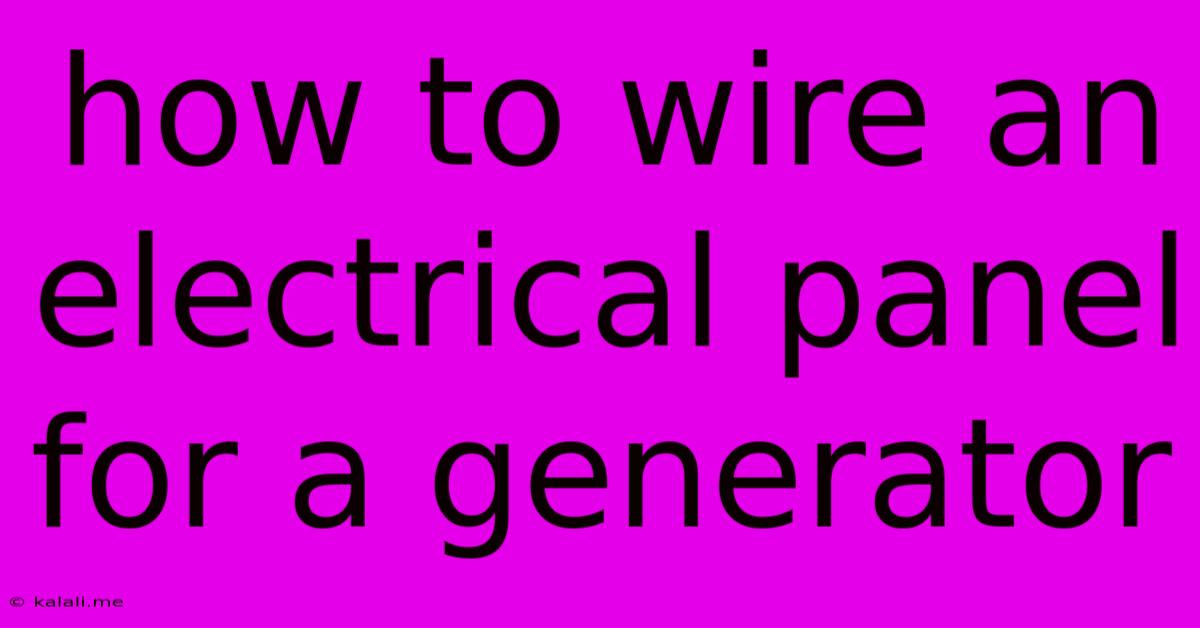How To Wire An Electrical Panel For A Generator
Kalali
Jun 03, 2025 · 4 min read

Table of Contents
How to Wire an Electrical Panel for a Generator: A Comprehensive Guide
Meta Description: Learn how to safely and effectively wire your electrical panel for a generator, ensuring power during outages. This guide covers necessary components, wiring diagrams, and crucial safety precautions.
Power outages can be disruptive, but a properly installed generator can provide much-needed peace of mind. This guide will walk you through the process of wiring your electrical panel for generator use, enabling you to power essential circuits during emergencies. Remember, working with electricity is dangerous. If you are not comfortable with electrical work, hire a qualified electrician.
Understanding the Process: Interlock and Transfer Switch
There are two primary methods for connecting a generator to your home's electrical panel: using an interlock kit or installing a generator transfer switch.
-
Interlock Kit: This is a simpler, more affordable option, but it's less safe and only suitable for smaller generators. An interlock kit physically prevents you from powering both the main breaker and the generator simultaneously, reducing the risk of backfeeding power to the grid. However, it only allows you to power a limited number of circuits.
-
Transfer Switch: This is the safer and more versatile option, allowing you to power a larger number of circuits selectively. A transfer switch acts as a secondary power source, safely disconnecting your home's main power supply before connecting the generator. This prevents backfeeding and protects utility workers. This is the recommended method for most homeowners.
Essential Components and Tools
Before starting, gather the necessary components and tools:
- Generator Transfer Switch: Choose a switch with an amp rating sufficient for your generator and the number of circuits you want to power.
- Generator: Ensure your generator is properly sized for your needs and compatible with the transfer switch.
- Wires: Use appropriately sized and rated wires for your generator and the circuits you’ll power.
- Circuit Breakers: Consider adding dedicated breakers for circuits you'll power from the generator.
- Electrical Panel: Access to your main electrical panel is crucial.
- Voltage Tester: Essential for safety checks before and after wiring.
- Wire Strippers and Cutters: For preparing the wires.
- Screwdrivers: For connecting wires and mounting the transfer switch.
- Electrical Tape: For insulating connections.
- Wire Connectors: For joining wires securely.
- Work Gloves and Safety Glasses: Crucial for personal safety.
Step-by-Step Wiring with a Transfer Switch (Recommended)
This process requires turning off your main power supply. Always double-check with a voltage tester before working on any electrical components.
- Turn off the Main Power: Turn off the main breaker at your electrical panel.
- Install the Transfer Switch: Mount the transfer switch according to the manufacturer’s instructions. This usually involves connecting it to your existing panel.
- Wire the Generator to the Transfer Switch: Connect the wires from your generator to the input terminals of the transfer switch following the wiring diagram provided with your specific switch.
- Wire the Selected Circuits to the Transfer Switch: Identify the circuits you want to power from the generator and connect them to the output terminals of the transfer switch. This requires carefully connecting wires to the appropriate breakers within the transfer switch.
- Test the Connection: Carefully re-engage the main breaker and use a voltage tester to confirm that all circuits are properly connected and functioning only when the generator is active.
- Testing the System: Start your generator and switch the transfer switch to the "generator" position. Check the functionality of each circuit you connected.
Safety Precautions: Always Prioritize Safety!
- Turn off the Main Power: Before any work, always turn off the main breaker and verify with a voltage tester.
- Use Proper Wire Sizing: Use wires appropriate for the amperage of your generator and circuits.
- Grounding: Ensure proper grounding of the generator and transfer switch to prevent electrical shocks.
- Proper Connections: Make sure all wire connections are tight and secure.
- Professional Help: If you are not comfortable working with electricity, hire a qualified electrician.
Conclusion:
Wiring your electrical panel for generator use offers a valuable safety net during power outages. By understanding the process, gathering the necessary components, and meticulously following safety guidelines, you can effectively prepare your home for emergencies. Remember, safety should always be your top priority. If you have any doubts, always consult a qualified electrician.
Latest Posts
Latest Posts
-
Hide Login Page If Logged In
Jun 05, 2025
-
What Hitpoints Does Python Staff Have
Jun 05, 2025
-
How To Get Rid Crazy Ants
Jun 05, 2025
-
Can You Use A 3 Way Switch For Single Pole
Jun 05, 2025
-
How To Calculate Exerting Force With Center Of Mass
Jun 05, 2025
Related Post
Thank you for visiting our website which covers about How To Wire An Electrical Panel For A Generator . We hope the information provided has been useful to you. Feel free to contact us if you have any questions or need further assistance. See you next time and don't miss to bookmark.